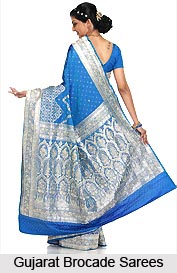 Gujarati brocade sarees are interwoven with rich traditional and advanced designs. The typical and classy zari blended with glossy and bright colors of silk add life to all festivals and ceremonies. These sarees are the representation of affluent cultural heritage. The Gujarati brocade sarees are distinguishable for their excellent designs that give them a separate characteristic.
Gujarati brocade sarees are interwoven with rich traditional and advanced designs. The typical and classy zari blended with glossy and bright colors of silk add life to all festivals and ceremonies. These sarees are the representation of affluent cultural heritage. The Gujarati brocade sarees are distinguishable for their excellent designs that give them a separate characteristic.
Beautiful floral borders, zalis or trellises and assorted geometrical motifs of the historical structures are finely woven with zari on silk surfaces. These colorful and dynamic patterns attract every heart.
The variety of rich and lavish colors applied and contrasted, make brocades visually tempting and appealing. Colors like Red, yellow, blue, green, ochre, brown in various shades and tones mixed in blazing gold and silver make brocades payable items and the most popular festive textiles too. Although there have been recent attempts to revive the Gujarati brocade silk saree industry which once thrived in Surat and Ahmedabad, today it is virtually extinct.
Traditional Trivia
Brocades are popular as a part of textile traditions since centuries. The history of Gujarat provides evidence that there existed booming brocade industry and workshops in Bharuch, Cambay and Ahmedabad. The main weaving centers for these sarees were Ahmedabad, Surat, Bharuch, Patan and Vadodara. It is worth mentioning that all these have their different specific styles. Other than this, the history also reveals that the beautiful intricate borders and pallus of Ashavali, woven by master craftsmen, existed even before the advent of Ahmed Shah. The weavers started incorporating them into the design palette along with patterns of animals and birds.
The work of design detailing and the ideas of colors and motifs are a result of external influences. The Mughal court and Persia resulted in heavier and enriched types of brocade. Some of these graced the Jharokhas at Fatehpur Sikri. The Oxus, which was an ancient trading partner, gave suggestions of designs to Gujarati craftsmen. As a result of it, Brocaded sashes and angarakshaks were modified. Other than the art of brocade, Saris, accessories and clothing were also depicted with vivid flowering and patronage in religion. The actions of Krishna and Gopis were also remained popular among all.
Brocade Weaving of Gujarat
Brocade Silk Sarees of Gujarat are the true instance of sheen and affluent cultural heritage of India. Its distinctive style and Brocade`s aesthetic images has raised its standard very high throughout the nation. Lustrous, glossy, bright colors and dynamic, classy, traditional designs used by the manufacturers have received fascinating customers from beyond the boundaries.
It is worth mentioning here that Jamnagar, Ahmedabad, Mehsana and Surat are the main Brocade weaving centers of the nation. The community involved in this craft form is Wankar and Maheshwari.
Features of Brocade Saree in Gujarat
Though this Gujarati Brocade sari attracts everybody, yet the ones who are into the work of saris themselves consider it very refined and phenomenal. The distinct feature of this particular type of saree is the design. These old brocades had such distinguishing characteristics as "buti" that are woven into the field in the warp direction instead of the weft. This makes the designs lie horizontally instead of vertically on the saree when it is draped. The floral designs are often woven in coloured silks against a golden ground fabric. The Gujarati brocade sarees usually incorporate leaves, flowers and stems outlined by a fine dark line. Moreover, intricately woven silken patterns were embedded into the gold surface. This work is done with the usage of a huge variation of colours and is known as `meenakari`. The traditional patterns which make the Brocade sarees more attractive are floral sprays, mango as a motif, stylized shrubs and a circular coin which is known as an `asharfi`.





















